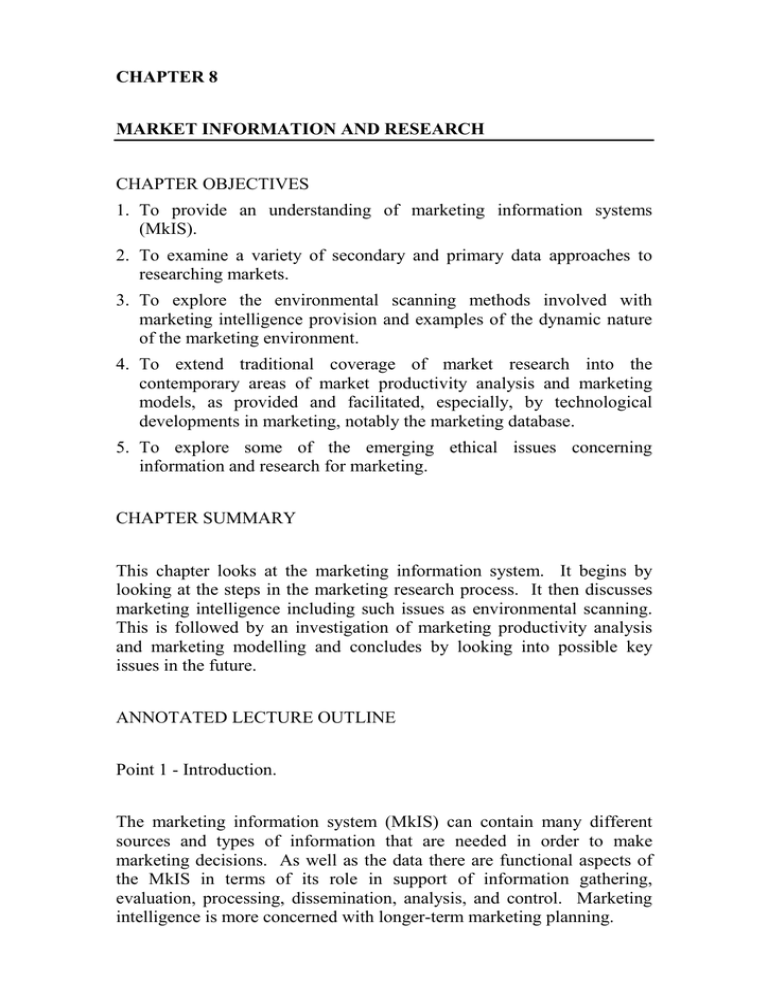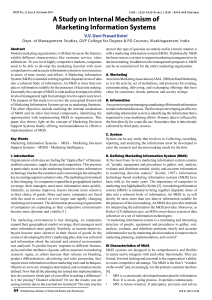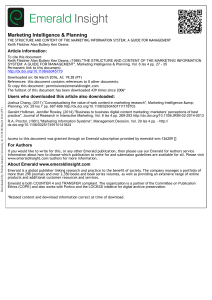CHAPTER 8 MARKET INFORMATION AND RESEARCH CHAPTER OBJECTIVES 1.
advertisement

CHAPTER 8 MARKET INFORMATION AND RESEARCH CHAPTER OBJECTIVES 1. To provide an understanding of marketing information systems (MkIS). 2. To examine a variety of secondary and primary data approaches to researching markets. 3. To explore the environmental scanning methods involved with marketing intelligence provision and examples of the dynamic nature of the marketing environment. 4. To extend traditional coverage of market research into the contemporary areas of market productivity analysis and marketing models, as provided and facilitated, especially, by technological developments in marketing, notably the marketing database. 5. To explore some of the emerging ethical issues concerning information and research for marketing. CHAPTER SUMMARY This chapter looks at the marketing information system. It begins by looking at the steps in the marketing research process. It then discusses marketing intelligence including such issues as environmental scanning. This is followed by an investigation of marketing productivity analysis and marketing modelling and concludes by looking into possible key issues in the future. ANNOTATED LECTURE OUTLINE Point 1 - Introduction. The marketing information system (MkIS) can contain many different sources and types of information that are needed in order to make marketing decisions. As well as the data there are functional aspects of the MkIS in terms of its role in support of information gathering, evaluation, processing, dissemination, analysis, and control. Marketing intelligence is more concerned with longer-term marketing planning. Point 2 - Marketing research. Marketing research is a key element of the MkIS and is concerned with the provision of information about markets and their reaction to marketing strategy. It is research about a specific problem not just the collection of data per se. Marketing research is systematic and formalized and there is a sequence of research events or stages known as the research process. (Box 8.2 pp153) Point 3 - Marketing intelligence. Marketing intelligence is concerned with the wider, external information available from the marketing environment. It is less focused than marketing research and is concerned with less immediate decisionmaking. If an organization is to anticipate customer requirements profitably then a degree of forecasting is required in order to plan ahead. Environmental scanning is seen as an early warning system for environmental forces (Jain 1981) which enable an organization to act rather than react to opportunities and threats and is, therefore, long-term. Techniques for scanning involve a six stage approach. Point 4 - Marketing productivity analysis. Marketing productivity analysis involves the use of internal information that is readily available to quantify marketing inputs and outputs, e.g. measuring the response to an advertising campaign in terms of increased sales. A new method of data collection in this area is transactional data which has led to more sophisticated and better targeted database marketing. Point 5 - Marketing modelling. The putting together of profile and transaction data has led to the development of biographics allowing companies to build an individual profile of someone’s life and this it is thought will be the basis of marketing modelling in the next few years. Point 6 - The future. As marketing moves more towards direct and database approaches it is felt that greater emphasis will be placed on behavioural response rather than attitudinal measures and that issues of privacy need to be addressed. Point 7 - Conclusion. As can be seen today’s MkIS is concerned with many areas of data collection. In addition to marketing research the scanning of the marketing environment is becoming increasingly important as is customer specific database marketing, the development of which is also giving rise to ethical concerns. Answers to the discussion questions:1. Here the discussion revolves around the Chartered Institute of Marketing’s definition of marketing and the fact that marketing research helps identify customer requirements and marketing intelligence helps in anticipating them. A discussion of how these information sources help with the decision-making process would be useful also. 2. Analysis of the six stages of the research process is required and students should be encouraged to identify what errors or bias can occur at each stage. 3. This information can then be presented to the rest of the group. 4. Consumer panels, a form of primary research, where consumers report their buying behaviour over a period of time. They look at the type of products bought and the frequency, etc. Retail audits, also continuous, are primary research, and allow sales by type of retail outlet to be analysed. They can also track distribution patterns, pricing and sales promotion activity including that of competitors. 5. Bayesian Analysis helps, by the use of probability theory, to estimate the value of decisions made without research information, compared with decisions made with information derived from different types of research design thus enabling the cost effectiveness of the research to be determined. 6. With observation there is little control over what is being studied. It is highly objective because actual behaviour is recorded as opposed to what the researcher thinks. Interviewing is more subjective although it depends upon the method being used. The more structured the interview the less subjective it is. 7. Group discussions are often used in conjunction with large-scale sample surveys to provide qualitative data. They can explore attitude and behavioural issues in much great depth. 8. Testing is a far more mechanical approach to analysing the success or otherwise of a direct marketing campaign. However, what it ignores is the attitude of consumers to the campaign which can only be determined through research. 9. a) This could be done by a systematic random sample where every nth consumers can be selected, or a stratified sample could be used. b) Quota methods are where relevant characteristics of the target market are accounted for in the sample. The sample should, therefore, represent the target market as a whole. 10. Students should be guided towards the six stage framework for environmental scanning given in the text (pp168). 11. Here Figure 8.4 (pp170) can be used as the basis for the discussion. a) It allows the production of league tables of types of customers for targeting purposes. b) It will take marketing modelling one step further to allow the modelling of individual buying behaviour. 12. Students will probably have some fairly strong views both for and against this argument! It can also lead to a discussion of how the industry should be controlled. MINI CASE Buy a car - and provide the marketer with a wealth of market information. 4HEDISCUSSIONHEREWILLREVOLVEAROUNDSOURCESOFSECONDARYDATA-INTEL AND+EY.OTEREPORTSMAYGIVEINFORMATIONONTHECARMARKETANDOUTLINE THEKEYCHANGESINBUYINGBEHAVIOURANDMARKETTRENDS2ELEVANTTRADE ASSOCIATIONSMAYALSOHAVEINFORMATIONTHATMIGHTBEUSEFUL)NADDITION THE)NTERNETMAYPROVIDETHECARDEALERWITHSOMEINTERESTINGINFORMATION





